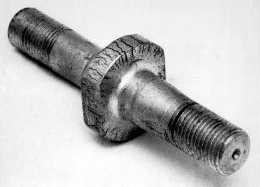T.O. 33B-1-1
3-101
e. Hydrogen Flakes. Flakes are internal ruptures that may occur in steel as the result of internal stresses
from metallurgical changes and decreased solubility of hydrogen from excessively rapid cooling. Flakes
usually occurring in fairly heavy sections and certain alloys are more susceptible than others. Figure 3-
57 shows magnetic particle indications of flakes that have been exposed on a machined surface. Since
these ruptures are deep in the metal - usually half way and more from the surface to the center of the
section they will not be shown by magnetic particle testing on the original surface of the part.
Figure 3-57. Magnetic Particle Indications of Flakes in a Bore of a Large Hollow Shaft.
f. Forging Bursts. When steel is worked at too high a temperature it is subject to cracking or rupturing.
Too rapid or too severe a reduction of section can also cause bursts or cracks. Such ruptures may be
internal bursts, or they may be cracks at the surface. Cracks at the surface are readily found by
magnetic particle testing. If interior, they are usually not shown except when they have been exposed by
machining. (See Figure 3-58.)
Figure 3-58. Magnetic Particle Indications of Forging Cracks
or Bursts in an Upset Section Severe Case.
g. Forging Laps. As the name implies, forging laps or folds are formed when, in the forging operation,
improper handling of the blank in the die causes the metal to flow so as to form a lap, which is later
squeezed tight. Since it is on the surface and is oxidized, this lap does not weld shut. This type of
discontinuity is sometimes difficult to locate, because it may be open at the surface and fairly shallow,
and often may lie at only a very slight angle to the surface. In some unusual cases it also may be solidly
filled with magnetic oxides. (See Figure 3-59 and Figure 3-60.)



